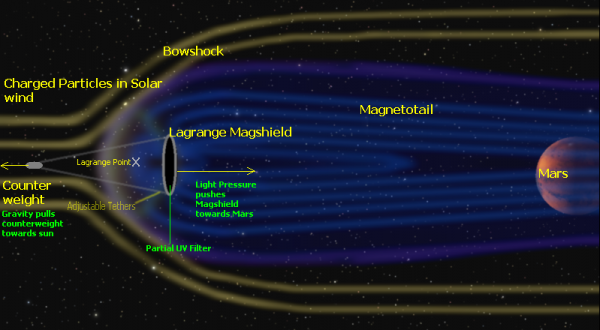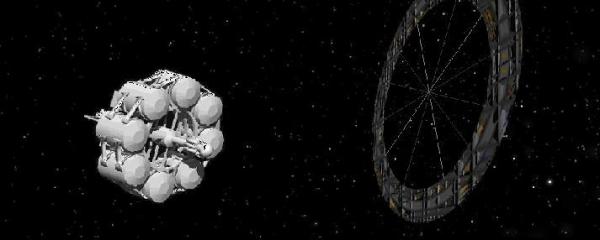BY LETTER
Lagrange Magshield, The
History > 0030 to 0900 AT: Solsys Era > 130 to 400 AT: The Interplanetary Age
Technology > Technology Type or Material > Drytech/Hylotech
Technology > Application > Infrastructure
Technology > Application > Megascale Engineering
Technology > Technology Levels > Middle Tech / Midtech
Technology > Technology Type or Material > Drytech/Hylotech
Technology > Application > Infrastructure
Technology > Application > Megascale Engineering
Technology > Technology Levels > Middle Tech / Midtech
Artificial planetary magnetic shielding | |
 Image from Steve Bowers | |
| Interplanetary Age concept, which was developed from research into magsails and Ram-assisted magscoops. | |
When the first efforts were made to terraform the planet Mars the lack of a protective magnetic field left that planet largely unprotected from the solar wind. An artificial magnetosphere was eventually constructed called the Lagrange Magshield, at the L1 Sun/Mars Lagrange point; this device is powered by solar energy and maintained in position by active control mechanisms.
Living on the surface of a terraformed world which does not have a magnetic field of its own exposes a human population to the full force of any solar wind events. These events can produce a lethal flux of charged particles, especially during a coronal mass ejection, when protons stream in relatively tight formation, which may hit an unprotected world (with dire consequences). Mars did once have a protective magnetic field, but when the small iron core cooled it lost that protection, and so the first great cities on Mars were all built partly or wholly beneath the surface to hide from the blustering solar wind.
In 2210 c.e. (Old Earth calendar) the franchise Exopower (Mars) began converting a small silicaceous asteroid 2133 PPTK into a flat ring of solar energy collectors at the Mars/Sun L1 Lagrange point, 1,081,000 km from Mars towards the Sun. Mars needed vast amounts of energy to continue the terraforming process, and this ring provided much of that power. However the repeated solar flux incidents threatened to make all the investment of time and energy worthless.
Exopower (Mars) in 2257 c.e. successfully demonstrated their new Lagrange Magshield concept, which had developed from research into superconductors, magsails and ram-assisted magscoops. The array of solar power collectors at the L1 point were formed into a flat ring with a hole in it (to allow visible sunlight and heat to reach Mars). These collectors provided power to a relatively small array of superconducting loops, which created an artificial magnetosphere and magnetopause, carefully crafted to reduce the flux of charged particles that reached the planet. A peak field strength of up to 10 petawatts could be produced, stronger than the field around the Earth; the solar wind could be diverted safely away from the Martian surface in this way.
Later a thin UV filter was added in the central hole. As the oxygen content of Mars' atmosphere increased, ultraviolet radiation from the Sun heated the topmost layer of the atmosphere (the Exosphere), and this caused the new atmosphere to be gradually lost. Introducing a UV filter between Mars and the Sun reduced this loss significantly.
Whenever the solar wind threatened to dump charged particles on the planet's surface, the magshield would adjust the anchorweight which pulled the structure towards the Sun against light pressure. An array of superconducting loops strung between the ring and the anchorweight produced a vast magnetic field of controlled strength. When the magnetic coils were energised, the whole array was blown outwards from the sun by solar wind, but adjustment to the anchorweight could prevent the magshield moving too far off station.
 Image from Steve Bowers | |
| The Magshield ring is seen in the distance as a freight ship makes its way towards Mars in the foreground | |
Together with an artificially maintained ozone layer, this magshield made the colonisation of Mars a viable proposition.
Magshields in the Current Era
Lessons learned during the partial terraforming of Mars have been used to good effect in other planetary systems, as many worlds need protection from the winds of the local star. Similar magshields are standard kit throughout the Terragen sphere, wherever a planet with no magnetic field is being terraformed. Many domed habitats and paraterraformed worlds have an artificial magnetic field built into their roof structures.A significant number of worlds are protected by advanced versions of Martian Lagrange Magshield technology. Such magshields may be relatively small, lightweight swarms orbiting the L1 point, or large continuous structures like the Martian original. The magshield can be configured to act as a parasol to cut down on unwanted radiation influx, and can collect a respectable amount of usable energy as well. Such a parasol is in place at the L1 point of Venus, for example.
Advanced anti-radiation genemodding is also commonplace, turning the galaxy from an inhospitable death-trap to the home for millions of clades of humanity and other biont organisms.
Related Articles
- Lagrange Points
- Mars
- Superconductivity - Text by M. Alan Kazlev; modified from KurzweilAI
The physical phenomenon whereby some materials exhibit zero electrical resistance at low temperatures. Superconductivity allows great computational power with little or no heat dissipation (the major limiting factor in all processing operations). The synthesizing of special materials enabling cheap and reliable room temperature superconductivity during the early Interplanetary Age represented a tremendous leap forward in many fields of technology. - Superconductors
Appears in Topics
| 130 to 400 AT: The Interplanetary Age | Drytech/Hylotech | Infrastructure |
| Megascale Engineering | Middle Tech / Midtech |
Development Notes
Text by Steve Bowers
Space freighter design by Eric Bury; model by RC2000.
Initially published on 12 May 2004.
A similar concept devised by NASA in 2017;
An Artificial Magnetic Shield Could Make Mars Habitable.
Also on YouTube.
Space freighter design by Eric Bury; model by RC2000.
Initially published on 12 May 2004.
A similar concept devised by NASA in 2017;
An Artificial Magnetic Shield Could Make Mars Habitable.
Also on YouTube.






